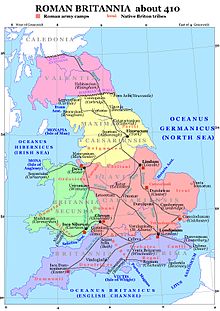Valentia (römische Provinz)
aus Wikipedia, der freien Enzyklopädie

Valentia war eine spätantike Provinz des Römischen Reiches im heutigen Großbritannien. Sie wurde nach Kaiser Valentinian I. benannt, der sie durch den comes Flavius Theodosius im Jahr 369 n. Chr. einrichtete.[1] Sie hatte einen consularis als Statthalter.[2]
Lage und Größe der Provinz sind in der Forschung umstritten. Vorgeschlagen wurden etwa das nördliche Wales oder eine Teilung der bestehenden Provinz Britannia secunda mit der Hauptstadt Eboracum (York). Valentia könnte dabei das Gebiet des heutigen Cumbria gewesen sein. Äußerst unwahrscheinlich ist, dass die Provinz, wie ältere Rekonstruktionen meinten, nördlich des Hadrianswalls im südlichen Schottland lag. Vorgeschlagen wurde auch, dass es sich bei Valentia nicht um eine Provinz handelte, sondern um die zeitweilige Benennung der Diözese der britannischen Provinzen.[3]
Literatur
[Bearbeiten | Quelltext bearbeiten]- J. G. F. Hind: The British ‘provinces’ of Valentia and Orcades (Tacitean echoes in Ammianus Marcellinus and Claudian). In: Historia. Band 34, 1975, S. 101–111.
- Peter Salway: Roman Britain. University Press, Oxford 1981. Paperback-Ausgabe 1984, Nachdruck 1990, ISBN 0-19-285143-8, S. 392–396. 411.
- Sheppard Frere: Britannia. A history of Roman Britain. 3rd further revised edition. Folio Society, London 1999, S. 205 (eingeschränkte Vorschau in der Google-Buchsuche).
- Anthony R. Birley: The Roman government of Britain. Oxford University Press, Oxford 2005, ISBN 0-19-925237-8, S. 399–400 (nicht ausgewertet).
Einzelnachweise
[Bearbeiten | Quelltext bearbeiten]- ↑ Ammianus Marcellinus 28, 3, 7.
- ↑ Notitia dignitatum Occ. 23.
- ↑ J. G. F. Hind: The British ‘provinces’ of Valentia and Orcades. In: Historia. Band 34, 1975, S. 101–111.
Text is available under the CC BY-SA 4.0 license; additional terms may apply.
Images, videos and audio are available under their respective licenses.
